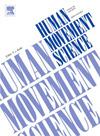Kinematic and kinetic characteristics of graphomotor skills in children with neurodevelopmental disorders: The impact of DCD, ADHD, and ASD traits
IF 1.9
3区 心理学
Q4 NEUROSCIENCES
引用次数: 0
Abstract
Interest in the development of handwriting skills has been increasing; however, there is no consensus on the handwriting abilities of children with developmental coordination disorder (DCD), attention-deficit/hyperactivity disorder (ADHD), and autism spectrum disorder (ASD), and the specific handwriting characteristics associated with each neurodevelopmental disorder remain unclear. This exploratory study examined the preliminary associations between graphomotor skills and neurodevelopmental traits in 17 children (aged 7–11 years) diagnosed with DCD, ADHD, or ASD. The evaluation included handwriting fluency assessments, kinematic/kinetic analyses, and assessments of neurodevelopmental disorder traits. The participants performed tracing tasks involving straight lines, sine waves, and triangular waves using the TraceCoder® system. Graphomotor kinematic/kinetic parameters, including deviation from the baseline, pen pressure, velocity, acceleration, jerk, and area, were quantified. Fluency was assessed using the Understanding Reading and Writing Skills of Schoolchildren II test. Neurodevelopmental traits were evaluated using the DCD Questionnaire, ADHD Rating Scale, and Autism Spectrum Quotient. Increased DCD, ADHD and ASD traits were correlated with deteriorations in graphomotor parameters, such as greater deviation, and increased acceleration, jerk, and pen pressure. In contrast, higher ASD traits were associated with improvements in handwriting fluency. These preliminary findings suggest that graphomotor characteristics may vary depending on specific neurodevelopmental traits, underscoring the potential value of tailored assessments and interventions.
神经发育障碍儿童书写运动技能的运动学和动力学特征:DCD、ADHD和ASD特征的影响
对书写技能发展的兴趣一直在增加;然而,关于发育性协调障碍(DCD)、注意缺陷/多动障碍(ADHD)和自闭症谱系障碍(ASD)儿童的书写能力尚无共识,而且每种神经发育障碍的具体书写特征仍不清楚。本探索性研究调查了17名被诊断为DCD、ADHD或ASD的儿童(7-11岁)的书写运动技能和神经发育特征之间的初步联系。评估包括书写流畅性评估、运动学/动力学分析和神经发育障碍特征评估。参与者使用TraceCoder®系统执行涉及直线、正弦波和三角波的跟踪任务。测量笔运动的运动学/动力学参数,包括与基线的偏差、笔压力、速度、加速度、震动和面积。流利程度是通过学童理解阅读和写作技能II测试来评估的。使用DCD问卷、ADHD评定量表和自闭症谱系商评估神经发育特征。DCD、ADHD和ASD特征的增加与书写运动参数的恶化相关,如更大的偏差、加速、抽搐和笔压的增加。相反,更高的ASD特征与书写流畅性的提高有关。这些初步发现表明,笔迹运动特征可能因特定的神经发育特征而异,强调了量身定制评估和干预的潜在价值。
本文章由计算机程序翻译,如有差异,请以英文原文为准。
求助全文
约1分钟内获得全文
求助全文
来源期刊

Human Movement Science
医学-神经科学
CiteScore
3.80
自引率
4.80%
发文量
89
审稿时长
42 days
期刊介绍:
Human Movement Science provides a medium for publishing disciplinary and multidisciplinary studies on human movement. It brings together psychological, biomechanical and neurophysiological research on the control, organization and learning of human movement, including the perceptual support of movement. The overarching goal of the journal is to publish articles that help advance theoretical understanding of the control and organization of human movement, as well as changes therein as a function of development, learning and rehabilitation. The nature of the research reported may vary from fundamental theoretical or empirical studies to more applied studies in the fields of, for example, sport, dance and rehabilitation with the proviso that all studies have a distinct theoretical bearing. Also, reviews and meta-studies advancing the understanding of human movement are welcome.
These aims and scope imply that purely descriptive studies are not acceptable, while methodological articles are only acceptable if the methodology in question opens up new vistas in understanding the control and organization of human movement. The same holds for articles on exercise physiology, which in general are not supported, unless they speak to the control and organization of human movement. In general, it is required that the theoretical message of articles published in Human Movement Science is, to a certain extent, innovative and not dismissible as just "more of the same."
 求助内容:
求助内容: 应助结果提醒方式:
应助结果提醒方式:


